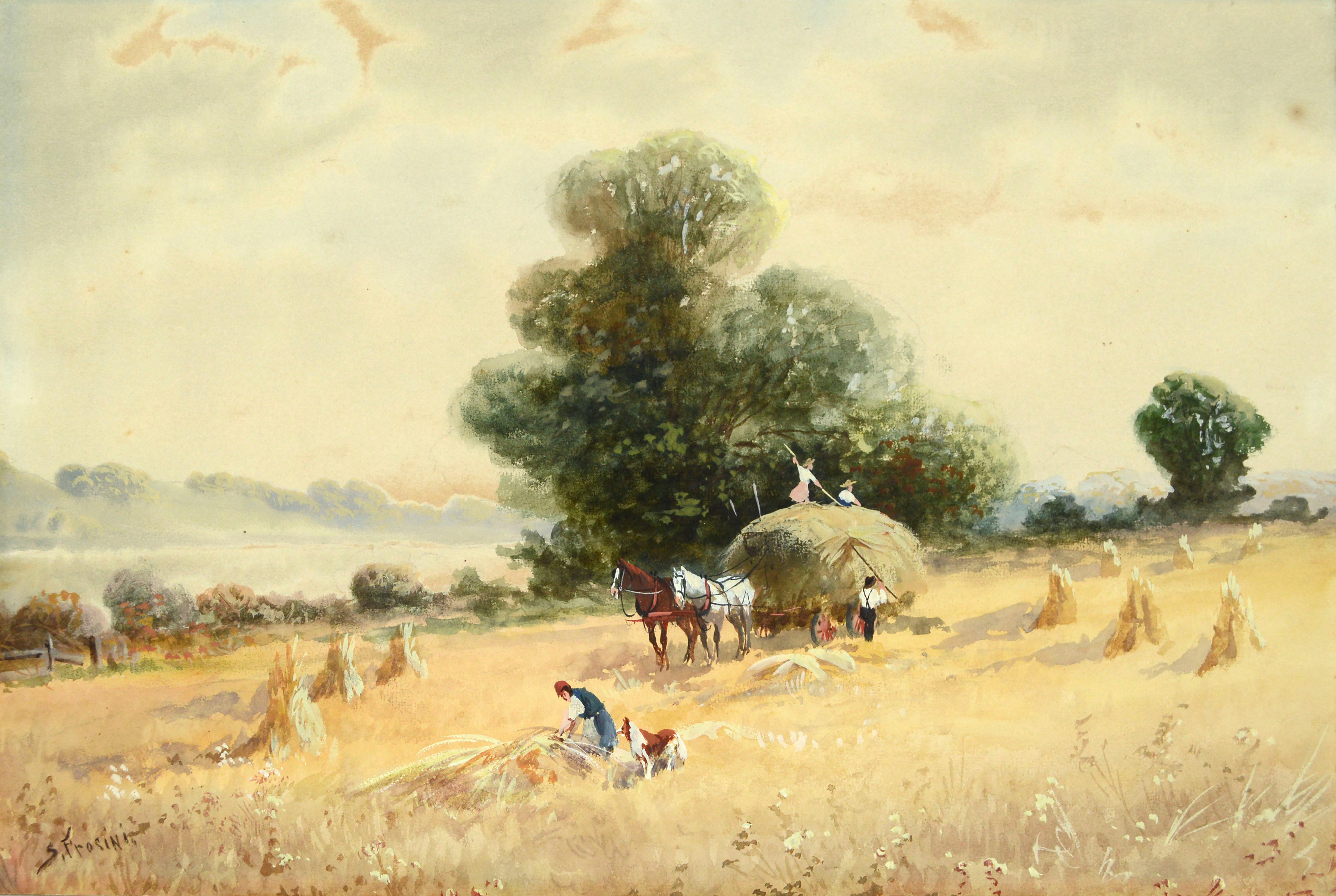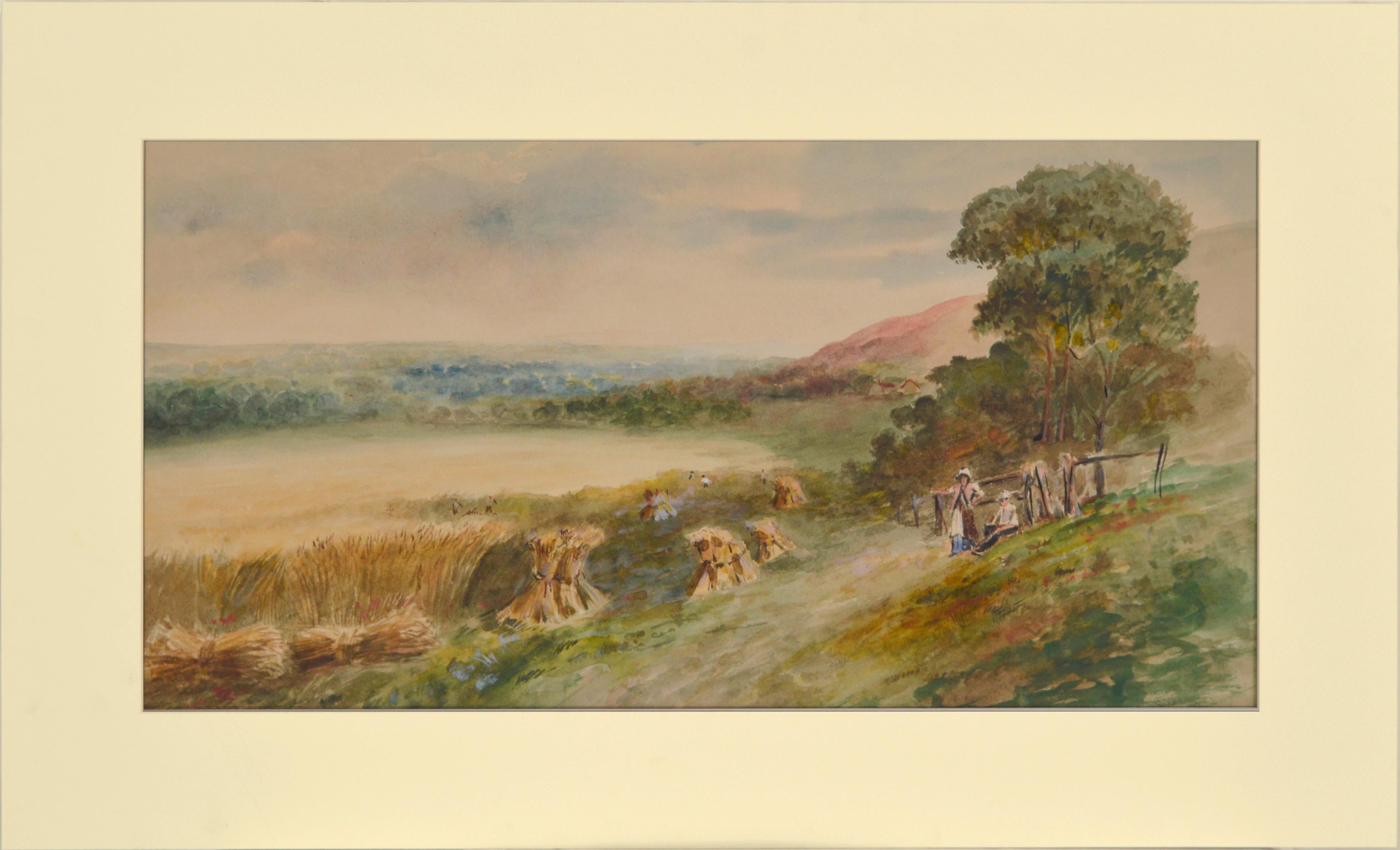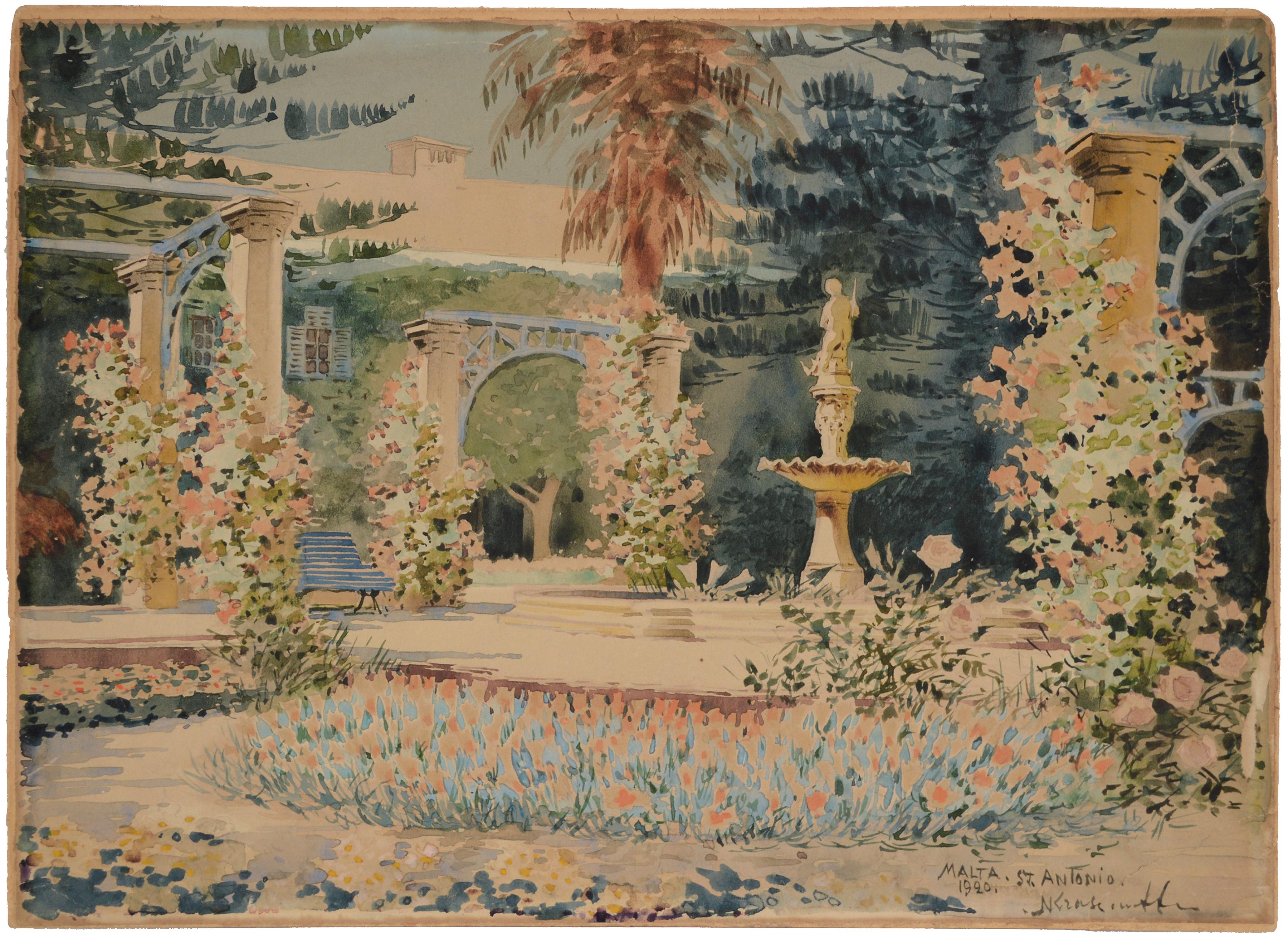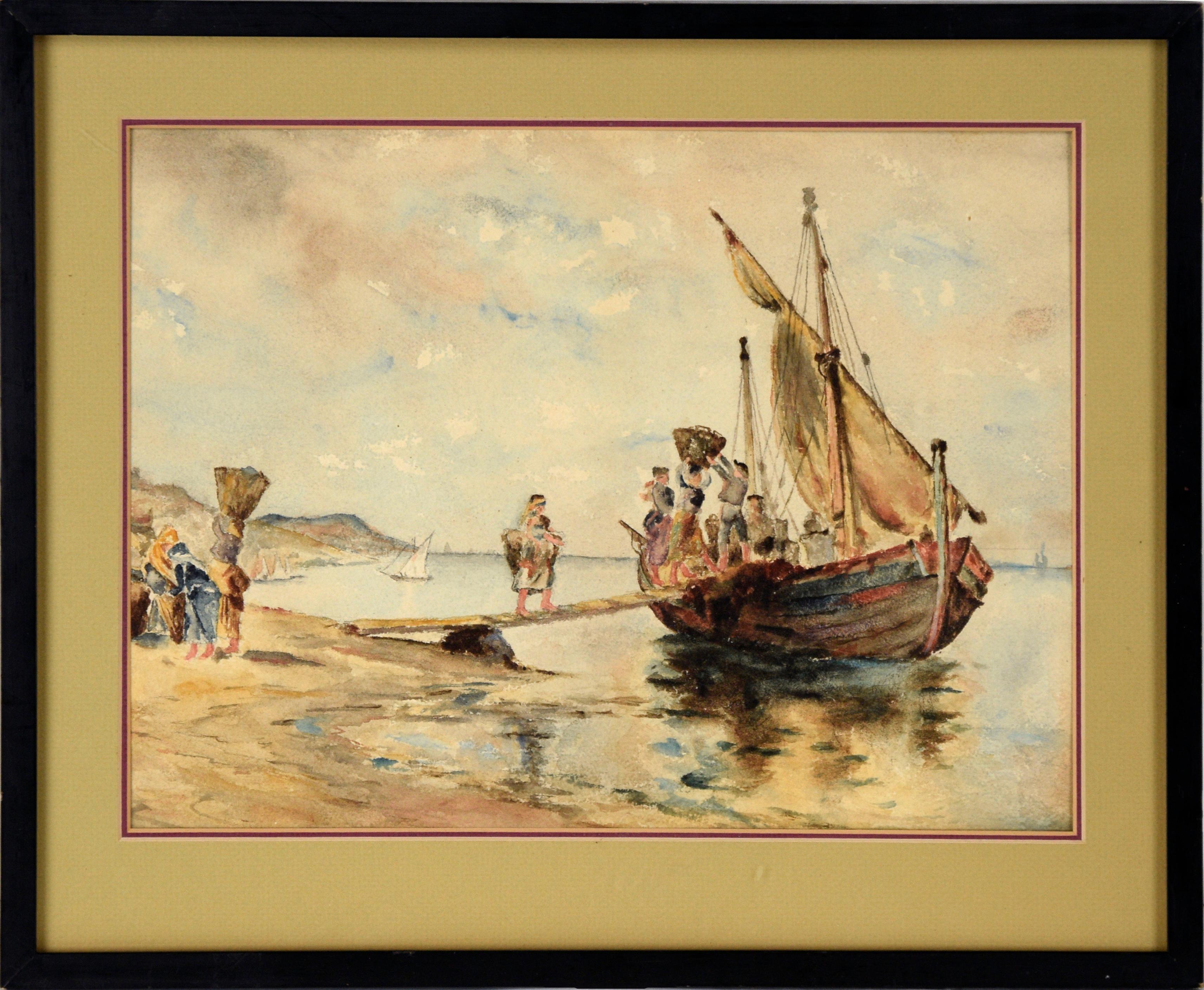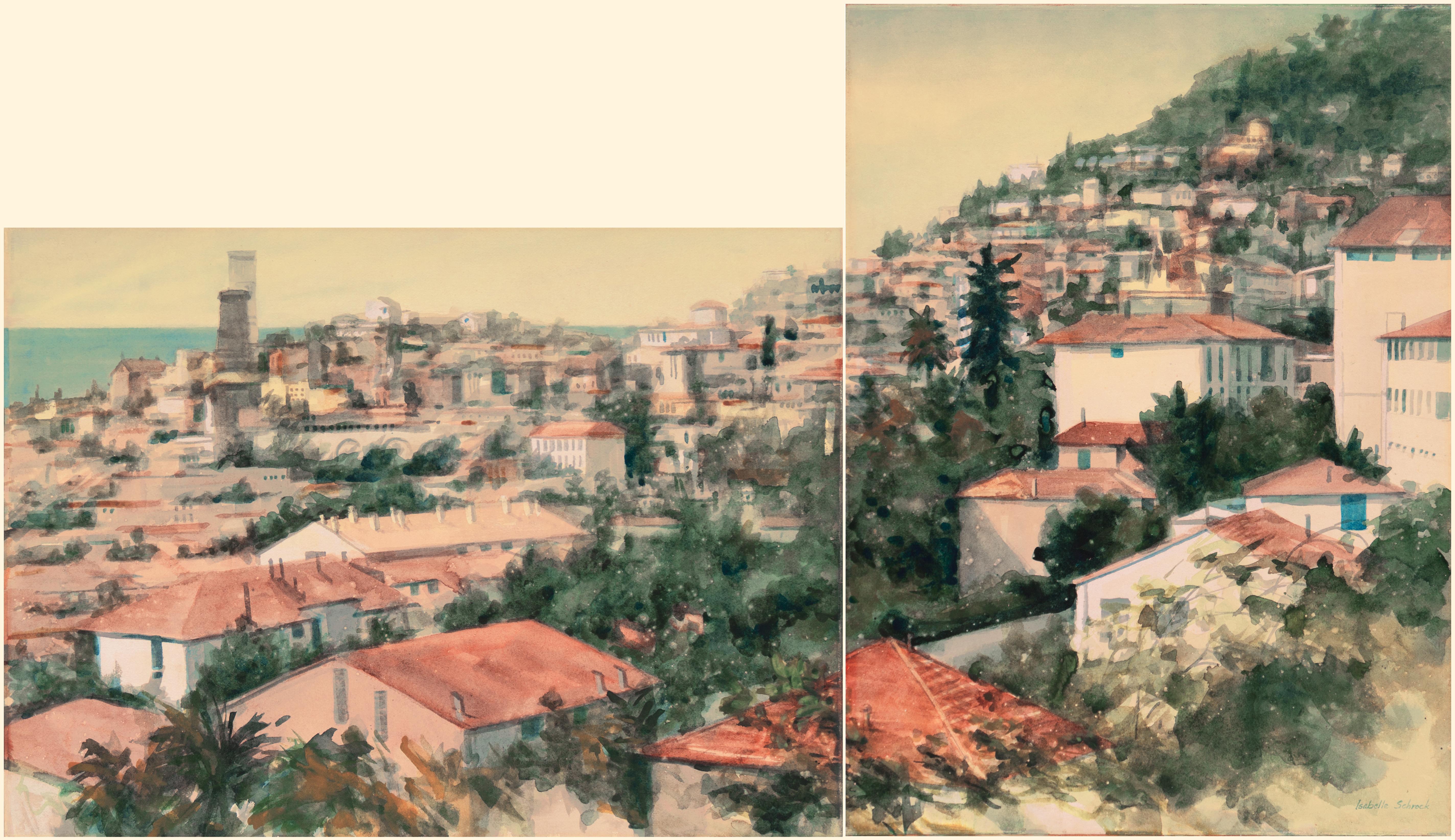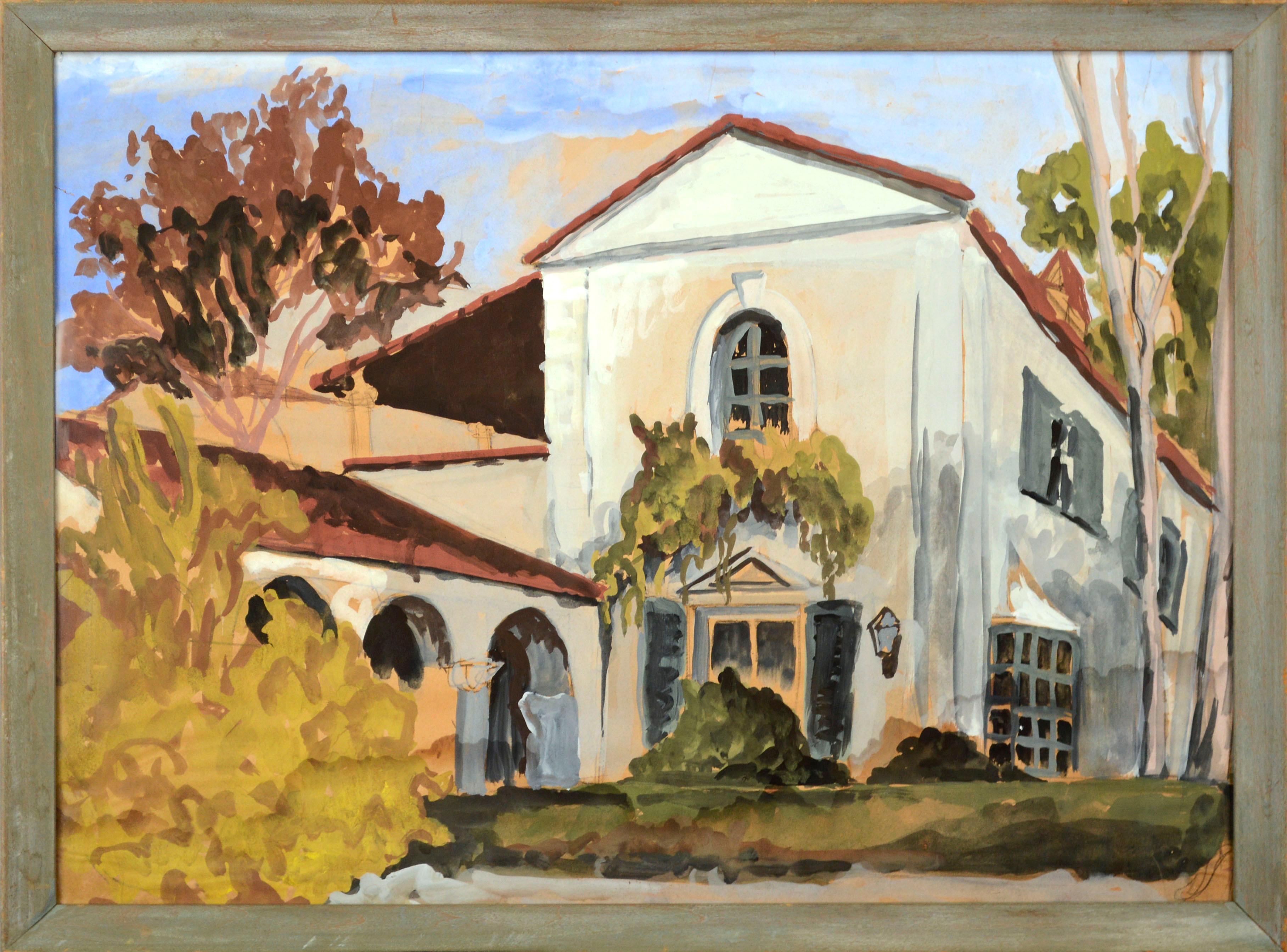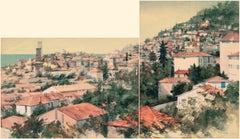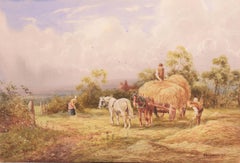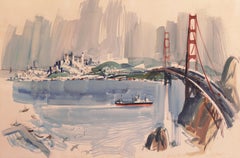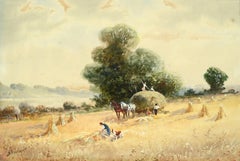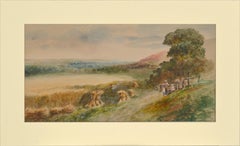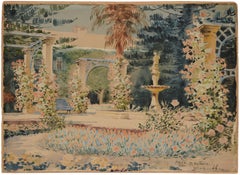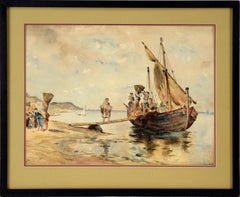Items Similar to 'Alpine Landscape in Piedmont', Munich School Professor
Want more images or videos?
Request additional images or videos from the seller
1 of 13
Hans Blum'Alpine Landscape in Piedmont', Munich School ProfessorCirca 1911
Circa 1911
$1,950
£1,477.99
€1,710.92
CA$2,752.89
A$3,065.57
CHF 1,600.60
MX$37,145.01
NOK 20,185.28
SEK 19,046.41
DKK 12,771.79
About the Item
Signed lower left, 'Hans Blum' (German, 1858-1942) and painted circa 1911.
Provenance: Exhibited, 'Jubiläums- Ausstellung der Münchener Künstler-Genossenschaft', München 1911 ('Anniversary Exhibition of the Munich Artists' Cooperative'). Label verso.
Hans Blum studied at the Munich Academy of Fine Arts with Ludwig von Löfftz and Ludwig Lindenschmit the Younger. He first worked as a portraitist in Nuremberg but later turned to genre painting, which he often carried out in the style of plein-air painting. Blum exhibited his Italian alpine landscapes widely and with success including at the Munich Exposition of 1909. He was also a respected teacher and was later appointed to a professorship at the Munich School of Applied Arts. Blum's work may be found in private and public collections including two works held in the permanent collection of the Nuremberg Art Museum.
Reference:
E. Benezit, Dictionnaire des Peintres, Sculpteurs, Dessinateurs, et Graveurs, Jacques Busse, 1999 Nouvelle Édition, Gründ 1911, Vol. 2, p. 422; Thieme-Becker Allgemeines Lexikon der Bildenden Künstler von der Antike bis zu Gengenwart, Ulrich Thieme and Felix Becker, Deutscher Taschenbuch Verlag 1992, Vol. 4, p. 142; Vollmer Allgemeines Lexikon der Bildenden Künstler des 20. Jarhhunderts, Hans Vollmer, Deutscher Taschenbuch Verlag 1992, Vol. 1, p. 237; Blum, Hans. In: Friedrich von Boetticher: Malerwerke des 19. Jahrhunderts. Beitrag zur Kunstgeschichte. Band 1/1, Bogen 1–30: Aagaard–Heideck. Fr. v. Boetticher’s Verlag, Dresden 1891, S. 107.; et al.
- Creator:Hans Blum (1858 - 1942, German)
- Creation Year:Circa 1911
- Dimensions:Height: 17.25 in (43.82 cm)Width: 12.25 in (31.12 cm)Depth: 0.13 in (3.31 mm)
- Medium:
- Movement & Style:
- Period:
- Condition:paper laid down on board, minor restoration, minor toning; unframed; shows well.
- Gallery Location:Santa Cruz, CA
- Reference Number:1stDibs: LU34416846362
About the Seller
5.0
Platinum Seller
Premium sellers with a 4.7+ rating and 24-hour response times
Established in 1982
1stDibs seller since 2013
744 sales on 1stDibs
Typical response time: 1 hour
- ShippingRetrieving quote...Shipping from: Santa Cruz, CA
- Return Policy
Authenticity Guarantee
In the unlikely event there’s an issue with an item’s authenticity, contact us within 1 year for a full refund. DetailsMoney-Back Guarantee
If your item is not as described, is damaged in transit, or does not arrive, contact us within 7 days for a full refund. Details24-Hour Cancellation
You have a 24-hour grace period in which to reconsider your purchase, with no questions asked.Vetted Professional Sellers
Our world-class sellers must adhere to strict standards for service and quality, maintaining the integrity of our listings.Price-Match Guarantee
If you find that a seller listed the same item for a lower price elsewhere, we’ll match it.Trusted Global Delivery
Our best-in-class carrier network provides specialized shipping options worldwide, including custom delivery.More From This Seller
View All'California Coastal Diptych', Berkeley, Bay Area Woman Artist, Smithsonian, CCAC
Located in Santa Cruz, CA
Signed lower right, second panel, 'Isabelle Schrock' for Isabelle Schrock Barnett (American, 1903-1995) and painted circa 1975. Additionally signed, verso, on each panel and titled, ...
Category
1970s Impressionist Landscape Drawings and Watercolors
Materials
Varnish, Watercolor, Gouache, Board, Laid Paper
'Harvest Time', Royal Birmingham Society of Artists, London Royal Academy
Located in Santa Cruz, CA
Signed lower right, 'H. Hammond' for Horace Murray Hammond (British, circa 1879-1966) and dated 1921.
A luminously painted, bucolic view of harvest time in England with the lilac of...
Category
1930s Landscape Drawings and Watercolors
Materials
Watercolor, Gouache, Illustration Board
'South-Western Landscape', Art Institute of Chicago, Whitney Museum, WPA, Odessa
By Todros Geller
Located in Santa Cruz, CA
Signed 'Todros Geller' (Russian-American, 1889-1949) and dated 1937
An elegant and painterly, southwestern landscape painted when the artist was 48 years old.
Born in Vinnytsia, no...
Category
1930s Landscape Drawings and Watercolors
Materials
Watercolor, Gouache, Illustration Board
'San Francisco from Marin', Seattle, SAM, Frye Museum, Golden Gate, Sausalito
Located in Santa Cruz, CA
Signed lower right, 'Jess Cauthorn' (American, 1923-2005), painted circa 1960.
A respected fine artist art teacher who transformed the art-school scene in Seattle, Jess Cauthorn's ...
Category
1960s Modern Landscape Drawings and Watercolors
Materials
Watercolor, Gouache, Illustration Board
'The Thief from François Villon's Christmas', San Francisco Bay Area Illustrator
By James March Phillips
Located in Santa Cruz, CA
Signed lower right, 'James March Phillips' (American, 1913-1981) and painted circa 1965.
Displayed in an original card mat decorated by the artist. Signed lower right, in pencil, 'J....
Category
1960s Landscape Drawings and Watercolors
Materials
Gouache, Illustration Board
'Moss Beach, Monterey, California', Pacific Coastal Landscape, ASL NYC, Benezit
By Elmer Wachtel
Located in Santa Cruz, CA
An early-20th-century, landscape showing a view of the coastline at Moss Beach in Monterey County with slate-blue skies overhead and a view towards a stand of windswept Monterey Cypr...
Category
Early 1900s American Impressionist Landscape Drawings and Watercolors
Materials
Paper, Watercolor, Gouache
You May Also Like
Wheat Field Harvest, Early 20th Century Figurative Landscape
Located in Soquel, CA
Early 20th century Italian figurative landscape of a traditional wheat field harvest scene, by S. Frosini (Italian, 20th Century). This figurative landscape in gouache depicts in gre...
Category
Early 20th Century Impressionist Figurative Drawings and Watercolors
Materials
Gouache, Illustration Board
$487 Sale Price
35% Off
Harvest Time The Hills of Mt Tamalpais near Lake Bon Tempe 1890s
Located in Soquel, CA
Harvest Time The Hills of Mt Tamalpais near Lake Bon Tempe 1890s
The Hills around San Rafael in the 19th century were a time of work and play as seen in this watercolor near Lake Bon...
Category
Late 19th Century American Impressionist Figurative Drawings and Waterco...
Materials
Watercolor, Illustration Board, Laid Paper
$1,440 Sale Price
20% Off
"San Anton Palace Malta" Early 20th Cent. Garden and Fountain Watercolor Russian
Located in Soquel, CA
A significant early 20th century landscape watercolor of the paradisical gardens at San Anton Palace in Attard, Malta by Nicholas Krasnoff, 1920 (Russian, 1864-1939). This beautiful piece is a wonderful example of the renowned Russian architect's prized watercolors, created while he was exiled to Malta in the early 1920's. Depicting a lush garden full of blooming, colorful flowers and a stately fountain at the San Anton Palace in Malta, one can see the deft hand and attention to detail rendered by the proficient artist and architect's hand.
Signed "N. Krasnoff" lower right. Titled and dated "Malta, St. Antonio 1920".
Unframed.
Measures 10.25"H x 14.25"W.
Right corner has a crease from being bent.
Nikolay Petrovich Krasnov, also known as Nicholas Krasnoff or Peter Nicholas Krasnoff, was a Russian Serbian architect and painter. He served as Chief Architect of Yalta, Crimea (1887-1899). From 1922 he lived and worked in the Kingdom of Yugoslavia, and was a key figure in the architectural development of Belgrade. Attending the Moscow School of Painting, Sculpture and Architecture in 1876, aged 12. As a young artist he received patronage from Sergey Tretyakov, brother of the founder of Moscow's Tretyakov Gallery, and entrepreneur Petar Gubonyin.
In 1887 Krasnov became Chief Architect in Yalta. At the age of 23, Krasnov had large responsibility for the rapid growth of the city. He expanded the promenade, which by 1913 became the city's main street, before creating a new city plan in 1889 (including a new sewer system, planning regulations, new streets, prevention of unregulated construction, a school and children's hospital, and the construction of the Pushkin Boulevard). Two concrete bridges were built over the river, and the embankment strengthened. Krasnov also ran a private practice in Yalta until 1911. Among his most famous work is the Livadia Palace, later the location of the 1945 Yalta Conference. Designed over 60 buildings in Crimea, blending a modernist style with local traditions. Also of note: Dulber Palace, Koreiz (1895-97), Alexander Nevsky Cathedral, Yalta (1902), Yusupov Palace, Koreiz (1909), Kokkoz Jami Mosque, Sokolyne (1910).
In 1913, he presented a collection of illustrations he had produced of his works to the Saint Petersburg Academy of Arts, where he held the title of academician. An opponent of the Russian Revolution, he left Yalta with his family in 1919 for Malta, alongside the Dowager Empress Marie Feodorovna, sister of Queen Alexandra, and over 600 members of the Russian aristocracy. Nikolay was in a group housed in the empty Villa St Ignatius, which had been a Jesuit college and then a hospital during World War I. To earn money, Nikolay painted many scenes of Malta, signing his paintings as N. Krasnoff. He is known as Nicholas Krasnoff in Malta. In May 2016 MaltaPost issued a commemorative set of stamps in his honor.
In 1922 Krasnov moved to Belgrade, then part of the Kingdom of Yugoslavia, where he became head of the Department of Monumental Architectural Developments and Monuments. His building designs in Serbia number around 60, and were created under the name Nikola Krasnov, as a mark of respect to his adopted homeland.
His key works in Belgrade include: Ministry of Forestry building (now Ministry of Foreign Affairs) (1923) which bears a memorial plaque...
Category
1920s Impressionist Landscape Drawings and Watercolors
Materials
Paper, Watercolor, Illustration Board
Loading the Cargo Ship - Brittany France - Watercolor 19th Century
Located in Soquel, CA
French Coastal Scene in Brittany with a merchant ship onloading fish and people by an unknown artist. A sailing vessel is anchored at a beach. A r...
Category
Late 19th Century Impressionist Figurative Drawings and Watercolors
Materials
Watercolor, Postcard, Illustration Board
$1,320 Sale Price
20% Off
Mid Century California Mission Landscape
Located in Soquel, CA
Beautiful mid century landscape of a historic California mission, highlighting its iconic architectural details such as a columned arches, white was...
Category
Mid-20th Century American Impressionist Landscape Paintings
Materials
Paper, Gouache, Cardboard
Environmental Prognostication Coil Narrative "Homo Sapiens R.I.P."
Located in Miami, FL
"They paved paradise and put up a parking lot," Joni Mitchell said. - - Created in 1969, at the dawn of the American environmental movement, artist Richard Erdoes draws a sequential narrative in the form of a coil. From inception to destruction, it illustrates a list of things that humans are doing to destroy the world we live in. The work was commissioned for school-age humans and executed in a whimsically comic way. Yet the underlying narrative is sophisticated and foreshadows a world that could be on the brink of ecological disaster.
Graphically and conceptually, this work exhibits an endless amount of creativity and Erdoes cartoony style is one to fall in love with.
Signed lower right. Unframed 12.4 inches Width: 12.85 inches Height is the live area. Board is 16x22 inches.
Richard Erdoes (Hungarian Erdős, German Erdös; July 7, 1912 – July 16, 2008) was an American artist, photographer, illustrator and author.
Early life
Erdoes was born in Frankfurt,to Maria Josefa Schrom on July 7, 1912. His father, Richárd Erdős Sr., was a Jewish Hungarian opera singer who had died a few weeks earlier in Budapest on June 9, 1912.After his birth, his mother lived with her sister, the Viennese actress Leopoldine ("Poldi") Sangora,He described himself as "equal parts Austrian, Hungarian and German, as well as equal parts Catholic, Protestant and Jew..."[4]
Career
He was a student at the Berlin Academy of Art in 1933, when Adolf Hitler came to power. He was involved in a small underground paper where he published anti-Hitler political cartoons which attracted the attention of the Nazi regime. He fled Germany with a price on his head. Back in Vienna, he continued his training at the Kunstgewerbeschule, now the University of Applied Arts, Vienna.[5] He also wrote and illustrated children's books and worked as a caricaturist for Tag and Stunde, anti-Nazi newspapers. After the Anschluss of Austria in 1938 he fled again, first to Paris, where he studied at the Academie de la Grande Chaumiere, and then London, England before journeying to the United States. He married his first wife, fellow artist Elsie Schulhof (d. xxxx) in London, shortly before their arrival in New York City.
In New York City, Erdoes enjoyed a long career as a commercial artist, and was known for his highly detailed, whimsical drawings. He created illustrations for such magazines as Stage, Fortune, Pageant, Gourmet, Harper's Bazaar, Sports Illustrated, The New York Times, Time, National Geographic and Life Magazine, where he met his second wife, Jean Sternbergh (d. 1995) who was an art director there. The couple married in 1951 and had three children.[6] Erdoes also illustrated many children's books.
An assignment for Life in 1967 took Erdoes to the Pine Ridge Indian Reservation for the first time, and marked the beginning of the work for which he would be best known. Erdoes was fascinated by Native American culture, outraged at the conditions on the reservation and deeply moved by the Civil Rights Movement that was raging at the time. He wrote histories, collections of Native American stories...
Category
1960s American Realist Landscape Drawings and Watercolors
Materials
Ink, Gouache, Illustration Board
